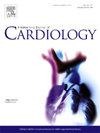经导管边缘到边缘二尖瓣修复患者与普通人群和心力衰竭人群的结果比较
IF 3.2
2区 医学
Q2 CARDIAC & CARDIOVASCULAR SYSTEMS
引用次数: 0
摘要
背景:关于在国内使用经导管边缘到边缘修复(TEER)治疗严重二尖瓣反流的信息仍然很少。目的:比较全国范围内因二尖瓣反流而接受TEER治疗的患者与背景人群和心衰患者对照的患者特征和一年的全因死亡率和心力衰竭住院率。方法:使用丹麦全国登记系统,确定所有首次TEER患者(2011-2020),并按性别、年龄和日历年按1:4的比例将其与背景人群和首次入院的HF人群进行匹配。不良结局采用累积发生率图和校正Cox回归分析进行评估。结果:我们纳入了423例接受TEER的患者和两个匹配的对照队列,每个队列包括1692人。中位年龄为76 岁(四分位数范围:70-84),男性居多(62.9 %)。接受TEER治疗的患者有相当大的合并症负担:慢性心衰(63.1 %),心房颤动(57.9 %)和糖尿病(20.8 %)。TEER组和hf组循环利尿剂的使用率分别为84.6 %和39.7 %。在teer组中,hf住院一年的全因死亡率累积发生率为21.3% %和31.2% %。与teer组比较:1年全因死亡率(背景队列:校正危险比[HR] 0.23(95 % CI): 0.17-0.31), hf队列:HR 1.33[95 % CI: 1.05-1.68]);1年hf住院(背景队列:HR 0.04[95 % CI: 0.02-0.07], hf队列:HR 1.11[95 % CI: 0.90-1.36])。结论:与背景人群相比,丹麦接受TEER治疗的患者存在合并症,症状性HF的指数程度更高,死亡率低于匹配的HF患者。本文章由计算机程序翻译,如有差异,请以英文原文为准。
Outcomes in patients undergoing transcatheter edge-to-edge mitral valve repair as compared to a general and heart failure population
Background
Information on the use of transcatheter edge-to-edge repair (TEER) in severe mitral regurgitation in national settings is still scarce.
Aims
To compare patient characteristics and one-year rate of all-cause mortality and heart failure (HF) hospitalization in a nationwide cohort of patients undergoing TEER for mitral regurgitation with controls from the background population and patients with HF.
Methods
Using Danish nationwide registries, all patients with first-time TEER (2011−2020) were identified and matched to the background population and a population with first-time admissions with HF on sex, age, and calendar year on a 1:4 ratio. Adverse outcome was assessed using cumulative incidence plots and adjusted Cox regression analyses.
Results
We included 423 patients undergoing TEER and two matched control cohorts consisting of 1692 people each. Median age was 76 years (interquartile range: 70–84) with a majority being male (62.9 %). Patients treated with TEER had a considerable burden of comorbidities: chronic HF (63.1 %), atrial fibrillation (57.9 %), and diabetes mellitus (20.8 %). Use of loop diuretics in the TEER- and HF-group was 84.6 % and 39.7 %, respectively. In the TEER-group the one-year cumulative incidence rate for all-cause mortality was 21.3 % and 31.2 % for HF-hospitalization. Compared with the TEER-group: one-year all-cause mortality (background-cohort: adjusted hazard ratio [HR] 0.23 (95 % CI): 0.17–0.31], HF-cohort: HR 1.33 [95 % CI: 1.05–1.68]); one-year HF-hospitalization (background-cohort: HR 0.04 [95 % CI: 0.02–0.07], HF-cohort: HR 1.11 [95 % CI: 0.90–1.36]).
Conclusions
Patients undergoing TEER in Denmark are comorbid compared to the background population and have a higher index degree of symptomatic HF with a lower mortality than a matched cohort of HF patients.
求助全文
通过发布文献求助,成功后即可免费获取论文全文。
去求助
来源期刊

International journal of cardiology
医学-心血管系统
CiteScore
6.80
自引率
5.70%
发文量
758
审稿时长
44 days
期刊介绍:
The International Journal of Cardiology is devoted to cardiology in the broadest sense. Both basic research and clinical papers can be submitted. The journal serves the interest of both practicing clinicians and researchers.
In addition to original papers, we are launching a range of new manuscript types, including Consensus and Position Papers, Systematic Reviews, Meta-analyses, and Short communications. Case reports are no longer acceptable. Controversial techniques, issues on health policy and social medicine are discussed and serve as useful tools for encouraging debate.
 求助内容:
求助内容: 应助结果提醒方式:
应助结果提醒方式:


